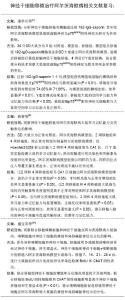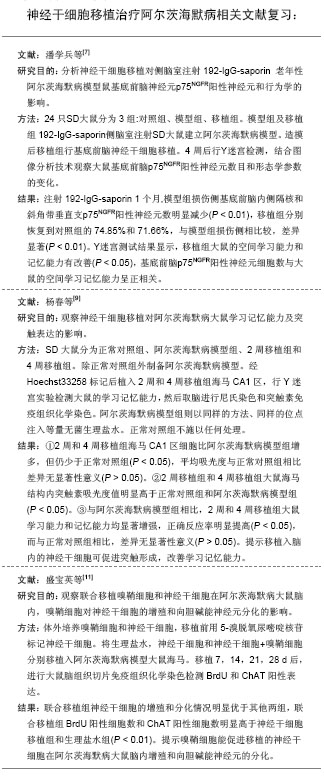Chinese Journal of Tissue Engineering Research ›› 2013, Vol. 17 ›› Issue (40): 7132-7137.doi: 10.3969/j.issn.2095-4344.2013.40.017
Previous Articles Next Articles
Stem cells for the treatment of Alzheimer’s disease
Liu Xiao-feng, Wu Di, Wu Yan
- Department of Histology and Embryology, College of Basic Medicine, Inner Mongolia Medical University, Hohhot 010110, Inner Mongolia Autonomous Region, China
-
Online:2013-10-01Published:2013-10-31 -
Contact:Wu Yan, M.D., Professor, Master’s supervisor, Department of Histology and Embryology, College of Basic Medicine, Inner Mongolia Medical University, Hohhot 010110, Inner Mongolia Autonomous Region, China yanw007@sina.com -
About author:Liu Xiao-feng★, Studying for master’s degree, Department of Histology and Embryology, College of Basic Medicine, Inner Mongolia Medical University, Hohhot 010110, Inner Mongolia Autonomous Region, China 457775641@qq.com -
Supported by:the Specific Funds for Stem Cells, Department of Finance, Inner Mongolia Autonomous Region, No. [2005]1162*; Stem Cell Application Technique Innovation Group Foundation, Department of Science and Technology, Inner Mongolia Autonomous Region, No. kjt09*
CLC Number:
Cite this article
Liu Xiao-feng, Wu Di, Wu Yan. Stem cells for the treatment of Alzheimer’s disease[J]. Chinese Journal of Tissue Engineering Research, 2013, 17(40): 7132-7137.
share this article

2.1 阿尔茨海默病的简介 阿尔茨海默病是一种进行性地致死性的神经退行性疾病。阿尔茨海默病多发病于老年期,病程缓慢且不可逆,是继心血管疾病、肿瘤和脑卒中之后威胁老年人健康的第4位杀手[1]。其病理改变主要为基底节区的脑细胞广泛死亡,乙酰胆碱化酶和乙酰胆碱含量显著减少[2],脑中广泛的神经纤维缠结(主要成分为高度磷酸化的tau蛋白)及脑内β-淀粉样蛋白过度积累等[3-4]。 2.2 阿尔茨海默病的传统治疗方法 阿尔茨海默病的传统治疗方法有药物治疗及免疫治疗等方法[5]。药物治疗是临床上最主要的治疗方法,它的治疗作用主要集中在维持退化的神经元功能,对早期的阿尔茨海默患者有一定的疗效,由于阿尔茨海默病起病较隐匿,不易察觉,患者大多在疾病的中晚期才开始治疗,因此药物治疗的效果不理想。阿尔茨海默病的免疫治疗包括主动免疫治疗和被动免疫治疗,但是由于不良反应大及治疗费用昂贵等原因限制了它的临床应用。 2.3 干细胞治疗阿尔茨海默病 1998年成功获得人胚胎干细胞后[6],由于干细胞具有自我更新和高分化潜能,这为阿尔茨海默病的治疗提供了新的思路,即利用干细胞的特性对阿尔茨海默病进行治疗。将体外扩增的神经干细胞移植到脑内,替代丢失和受损的神经细胞,修复神经系统。干细胞治疗阿尔茨海默病的可能机制为:分化成神经样细胞、分泌营养因子、促进内源性修复、刺激血管再生及作用于炎性细胞等。 2.3.1 神经干细胞治疗阿尔茨海默病 神经干细胞能够自我复制,并能够在一定的微环境中分化产生神经元。目前神经干细胞在动物实验上取得了很大的进展。应用免疫毒素192-IgG-saporin注射入SD大鼠脑内建立胆碱能系统损伤的阿尔茨海默病模型,对其进行基底前脑神经干细胞移植治疗。移植后,损伤侧内侧隔核、斜角带核p75NGFR阳性神经元计数的面积、周长、灰度均增加;SD大鼠学习、记忆能力较之前有所改善。移植的神经干细胞对192-IgG-saporin阿尔茨海默病模型大鼠基底前脑退变的p75NGFR阳性神经元数目具有补充和保护的作用[7]。 突触素是一种位于突触前囊泡内的糖蛋白,它的表达可以反映突触的发生和密度,是突触重建的重要标志之一[8],因此通过检测突触素的表达,可用来探讨神经干细胞移植入阿尔茨海默病模型大鼠脑内的效果。神经干细胞移植后,阿尔茨海默病模型大鼠脑内海马CA1区神经元数目增多,海马结构突触素吸光度值明显升高,阿尔茨海默病模型大鼠学习能力和记忆能力均有显著提高。神经干细胞在阿尔茨海默病模型大鼠脑内不仅能够存活、增殖,而且可替代损伤或坏死的神经细胞而重建神经通路,改善学习记忆能力[9]。 许旺细胞能够促进神经干细胞增殖,因此在治疗阿尔茨海默病模型大鼠时,将许旺细胞与神经干细胞一同移植到阿尔茨海默病模型大鼠脑中,观察联合移植对阿尔茨海默病模型大鼠的影响。发现联合移植组对阿尔茨海默病模型大鼠的学习和记忆能力的改善有明显的疗效,且优于神经干细胞单独移植组[10]。嗅鞘细胞能产生多种使神经干细胞增殖与向神经元分化的神经营养因子,将嗅鞘细胞与神经干细胞共同移植入阿尔茨海默病模型大鼠脑中,移植后,联合移植组神经干细胞存活数量较多,神经干细胞向胆碱能神经元的分化的细胞数量明显增多。嗅鞘细胞能促进移植的神经干细胞在阿尔茨海默病模型大鼠脑内增殖和向胆碱能神经元的分化[11]。 阿尔茨海默病中胆碱能系统的功能障碍是影响患者认知功能的主要原因,阿尔茨海默病患者乙酰胆碱转移酶的活性降低。对神经干细胞的基因进行修饰,使神经干细胞过度表达乙酰胆碱转移酶,将该神经干细胞移植入阿尔茨海默病模型大鼠脑中培养,阿尔茨海默病模型大鼠的乙酰胆碱水平基本恢复,阿尔茨海默病模型大鼠的学习和记忆功能可以与正常对照组媲美。该实验在基因的水平上改变了被移植的神经干细胞的特性,同时也从另一方面证明了乙酰胆碱转移酶在治疗阿尔茨海默病中的关键作用[12]。 神经干细胞治疗阿尔茨海默病动物模型已取得一定程度的进展,之后又利用某些细胞能营养神经干细胞的特点,将其与神经干细胞联合移植治疗阿尔茨海默病;还对神经干细胞的基因进行了修饰,改善神经干细胞的功能,增强了神经干细胞治疗阿尔茨海默病的疗效。但是目前神经干细胞增殖、分化、迁移以及与组织结构融合的细胞内、外环境调节控制机制尚不清楚,对移植后神经干细胞迁移速度、分化方向尚缺乏有效的调节手段,并且神经干细胞的免疫原性强,这使其临床应用较为困难,因此需要选用免疫原性较弱的干细胞来治疗。 2.3.2 间充质干细胞治疗阿尔茨海默病 间充质干细胞具有自我更新能力及多向分化潜能,其来源丰富,采集方便,可自体回输,较少发生免疫排斥反应,体外扩增迅速,短期内即可达到治疗所需细胞数量,容易转入外源基因,较少出现胚胎干细胞移植时发生的不恰当分化(致畸胎瘤),因此间充质干细胞具有广阔的临床应用前景。 β-淀粉样蛋白过度积累是阿尔茨海默病的主要病理变化[4],研究证明,细胞间的tau蛋白缠结的形成是阿尔茨海默病的另一种毒害神经的病因[3]。将骨髓间充质干细胞移植到阿尔茨海默病模型小鼠上,培养1个月后移植组的β-淀粉样蛋白40和42水平下降,脑部斑块所占的面积比对照组小,大脑皮质和海马处的tau蛋白明显降低。向阿尔茨海默病模型小鼠大脑内移植骨髓间充质干细胞不仅能减少β-淀粉样蛋白的过度积累和磷酸化的tau蛋白,还能降低由于β-淀粉样蛋白积累导致的小鼠的空间记忆力和认知功能的损害[13]。 脑源性神经营养因子有助于神经存活,促进神经干细胞向神经元分化,并促使其成熟[14]。将脑源性神经营养因子的基因修饰到骨髓间充质干细胞上,利用基因修饰过的骨髓间充质干细胞治疗阿尔茨海默病模型大鼠。移植1个月后检测到修饰组P-tau (Ser199/202)及tau-5蛋白的表达降低,大脑皮质及海马的β-淀粉样蛋白表达与正常对照组之间差异不大,光学显微镜下海马CA1区神经细胞数多。脑源性神经营养因子修饰的骨髓间充质干细胞可以降低阿尔茨海默病模型大鼠大脑皮质及海马β-淀粉样蛋白40,42含量,减轻tau蛋白磷酸化,减轻海马CA1区神经元退行性变,对神经元具有保护作用,且其作用优于未修饰骨髓间充质干细胞组[15]。 脐带间充质干细胞具有稳定的免疫学特性和无毒性[16],研究表明间充质干细胞移植的治疗效果与它同宿主细胞之间动态的、交互的旁分泌作用有关[17]。将雄性C57小鼠进行造模,造模后给予人脐带间充质干细胞治疗,治疗后,阿尔茨海默病模型小鼠的逃避潜伏期能够缩短;促炎因子白细胞介素1β、肿瘤坏死因子α水平升高幅度略有下降。进一步提示,人脐带间充质干细胞促进了阿尔茨海默病模型小鼠学习和记忆功能的恢复。人脐带间充质干细胞治疗阿尔茨海默病模型小鼠,可以通过调节免疫应答的途径来增加脑组织中正常神经元、神经干细胞的恢复,分化替代阿尔茨海默病的病变神经细胞[18]。 将人羊膜间充质干细胞尾静脉移植治疗阿尔茨海默病模型小鼠后,观察人羊膜间充质干细胞移植前后,小鼠脑组织中GFAP、Nestin和NSE的表达,这3种蛋白在脑组织中的阳性表达对大脑正常功能的发挥起着重要作用。人羊膜间充质干细胞移植后,海马区及两侧GFAP的表达比移植前提高了近4倍,几乎接近于正常组小鼠的表达量;移植组脑组织中Nesting阳性表达量有10%左右的提高,但不超过正常组;移植组脑组织中NSE阳性表达量下降了近1/3,但仍高于正常组。实验证明通过尾静脉移植人羊膜间充质干细胞,来增加阿尔茨海默病模型小鼠脑组织中星形胶质细胞和神经干细胞以及神经元细胞的表达,弥补阿尔茨海默病病程中丢失或损伤的神经细胞,对阿尔茨海默病模型小鼠有积极的治疗效果,这可能是人羊膜间充质干细胞治疗阿尔茨海默病的机制[19]。 脂肪间充质干细胞是一类来源于脂肪组织的间充质干细胞,可以迅速分裂和分化成间充质细胞,较骨髓间充质干细胞有更低的衰老率,且具有神经分化潜能[20]。考虑到细胞获得的难易程度、对患者的损伤程度以及是否易分化为神经细胞的能力来看,脂肪间充质干细胞预测其很可能在阿尔茨海默病治疗中发挥重要作用。目前已成功将脂肪间充质干细胞诱导成神经细胞,诱导出的神经细胞可以直移植到阿尔茨海默病患者脑内发挥作用,也可以继续诱导成胆碱能神经细胞再移植入阿尔茨海默病患者脑内发挥功能[21]。 间充质干细胞在体内分布较广,但骨髓间充质干细胞取材时对患者有损伤,即使是健康供者,也不能抽取太多的骨髓,这限制了骨髓间充质干细胞临床应用;胎盘和脐带来源的间充质干细胞,虽然对患者没有损伤,但是来源却很短缺,也阻碍的其应用;脂肪间充质干细胞来源丰富,免疫原性低,极易分化为神经细胞的特点有可能使其成为治疗阿尔茨海默病的应用较广的多能干细胞。 2.3.3 诱导多能干细胞治疗阿尔茨海默病 2006年,Takahashil等[22]报告了他们利用鼠成纤维母细胞诱导产生了类似胚胎干细胞的诱导干细胞,这种被诱导而形成的干细胞即诱导多能干细胞。他们发现Fbx15因子的表达可以用来检测新诱导形成细胞的多能性,并且只要细胞共同表达Oct4, Sox2, Klf4 和 C-myc这4个细胞因子,就可以产生表达Fbx15因子的克隆体,这种克隆体在形态学、表面标记物、基因表达和细胞增殖都与胚胎干细胞相似,甚至移植后也会产生畸胎瘤。2007年Takahashil等[23]通过表达这4个细胞因子,发现人类的皮肤成纤维细胞也可以被诱导成诱导多能干细胞,因此人类可以用诱导多能干细胞作为细胞替代治疗的另一种细胞来源。对于阿尔茨海默病这类神经退行性改变的疾病,诱导多能干细胞的优势有来源很稳定、不会产生免疫排斥反应、生成并不会涉及诸如损伤人类胚胎及克隆人这样的道德伦理问题,因此诱导多能干细胞可以代替其他干细胞移植治疗阿尔茨海默病。 神经干细胞和脑膜细胞因为高表达胚胎主要调节因子Sox2,所以更容易被诱导成诱导多能干细胞[24],因为神经干细胞的获取存在很大的局限性,由脑膜细胞诱导产生的诱导多能干细胞更适合阿尔茨海默病的细胞移植治疗。将小鼠脑膜来源的诱导多能干细胞诱导分化成神经前体细胞,并且进一步的分化形成神经元、星形胶质细胞和少突胶质细胞。小鼠脑膜细胞来源的诱导多能干细胞具有与胚胎干细胞相似的神经发生能力,体外诱导诱导多能干细胞还可以分化形成患者特异的神经细胞,更有利于治疗神经系统退行性疾病[25]。 人类诱导多能干细胞研究的发展将为阿尔茨海默病这类神经退行性疾病提供更有效的治疗措施。但是,在真正应用于临床治疗之前,还有许多问题尚未解决:如诱导体细胞重编程为诱导多能干细胞的机制目前还不清楚;诱导多能干细胞的诱导分化是否与胚胎干细胞的诱导条件相同还不得而知。分子遗传学研究已经鉴定出APOE、PS1、PS2及APP基因突变是导致阿尔茨海默病的主要遗传因素[26],实验证明对阿尔茨海默病患者诱导多能干细胞分化的神经细胞进行较长时间培养和分析可能会引起PS1及PS2基因突变,影响神经细胞形态和功能的表型改变[27]。在治疗时所需的诱导多能干细胞数目是多少,怎样把握细胞量,也是待解决的问题。因此,科学家们还在寻找优化建立诱导多能干细胞的方法,提高诱导多能干细胞制备效率,建立高效、安全、实用的制备人诱导多能干细胞的方法。 "

| [1]陈晓密. 如何简单识别老年性痴呆[J]. 医学信息,2011,24(8): 5194-5194. [2]程书珍,王丽君,刘恒,等.通经补肾复方对铝诱导阿尔茨海默病模型大鼠海马乙酰胆碱酯酶、胆碱乙酰转移酶、乙酰胆碱的影响[J].2012,32(12):4673-4674. [3]Hampel H,Wilcock G,Andrieu S,et al.Biomarkers for Alzheimer's disease therapeutic trials. Progress in Neurobiology. 2011;95(4):579-593. [4]Broersen K, Jonckheere W,Rozenski J,et al.A standardized and biocompatible preparation of aggregate-free amyloid beta peptide for biophysical and biological studies of Alzheimer's disease.Protein Engineering,Design&Selection.2011;24(9): 743-750. [5]林盛.阿尔茨海默病68例药物治疗效果及发病机制探讨[J].当代医学,2012,18(33):10-11. [6]Thomson JA,Itskovitz-Eldor J,Shapiro SS,et al.Embryonic Stem Cell Lines Derived from Human Blastocysts. Science. 1998;282:1145-1147. [7]潘学兵,龙大宏,罗秀梅,等. 神经干细胞移植对192-IgG-saporin阿尔茨海默病模型鼠基底前脑神经元p75NGFR阳性神经元和行为学的影响[J].中国组织工程研究与临床康复,2010, 14(45):8426-8430. [8]Xu L, Ryugo DK, Pongstaporn T, et al. Human neural stem cell grafts in the spinal cord of SOD1 transgenic rats: differentiation and structural integration into the segmental motor circuitry. Comp Neurol.2009;514(4):297-309. [9]杨春,周辉,白琳琳,等.神经干细胞移植对阿尔茨海默病大鼠海马突触素表达和学习记忆能力的影响[J].中国组织工程研究与临床康复,2010,14(10):1803-1807. [10]Zhan Y, Ma DH, Zhang Y. Effects of cotransplantated Schwann cells and neural stem cells in a rat model of Alzheimer’s disease.Neural Regeneration Research. 2011;6(4):245-251. [11]盛宝英,李洋,姜尧佳,等.嗅鞘细胞和神经干细胞联合移植阿尔茨海默病大鼠脑内的增殖和定向分化[J].中国组织工程研究与临床康复,2011,15(49): 9186-9189. [12]Park D, Joo SS , Kim TK ,et al . Human Neural Stem Cells Overexpressing Choline Acetyltransferase Restore Cognitive Function of Kainic Acid-Induced Learning and Memory Deficit Animals.Cell Transplantation.2012;21: 365-371. [13]Lee JK ,Jin HK,Endo H,et al.Intracerebral Transplantation of Bone Marrow-Derived Mesenchymal Stem Cells Reduces Amyloid-Beta Deposition and Rescues Memory Deficits in Alzheimer ’s disease Mice by Modulation of Immune Responses. Stem Cells.2010;28: 329-343. [14]Venkataramana NK, Kumar SK,Balaraju S, et al. Open-labeled study of unilateral autologous bone-marrow-derived mesenchymal stem cell transplantation in Parkinson’s disease. Transl Res.2010;155(2):62-70. [15]魏昌秀,代宏,陈松林.脑源性神经营养因子基因修饰骨髓间质干细胞移植痴呆大鼠大皮质及海马tau蛋白、β-淀粉样蛋白及神经元超微结构的变化[J].中国组织工程研究与临床康复,2010, 14(45): 8421-8425. [16]Lazarov O, Marr RA. Neurogenesis and Alzheimer's disease: at the crossroads. Experimental Neurology.2010; 223(2): 267-281. [17]Parekkadan B,Milwid JM.Mesenchymal stem cells as therapeutics. Annual Review of Biomedical Engineering. 2010;12:87-117. [18]于程程,汤勇勇,盛宏霞,等. 人脐带来源间充质干细胞移植急性阿尔茨海默病模型小鼠引发的免疫应答反应[J].中国组织工程研究,2012,16(19): 3476-3481. [19]王成春,杨波,关方霞,等.人羊膜间充质干细胞静脉移植治疗转基因 APP+小鼠的机制[J].中国组织工程研究与临床康复,2010, 14(19):3471-3476. [20]Hermann A, Gastl R, Liebau S,et al. Efficient generation of neural stem cell-like cells from adult human bone marrowstromal cells.Journal of Cell Science. 2004;117(19): 4411-4422. [21]Niu Y,Gong K,Ao Q,et al.Adipose derived mesenchymal stem cell transplantationfor Alzheimer’s disease.Zhongguo Zuzhi Gongcheng Yanjiu yu Linchuang Kangfu.2009;13(27): 5389-5391. [22]TakahashiI K,Yamanaka S.Induction of Pluripotent Stem Cells from Mouse Embryonic and Adult Fibroblast Cultures by Defined Factors.Cell.2006;126: 663-676. [23]TakahashiI K,Tanabe1 K,Ohnuki1 M,et al. Induction of pluripotent stem cells from adult human fibroblasts by defined factors. Cell.2007;131: 861-872. [24]Kim JB, Sebastiano V, Wu GM, et al.Oct4-induced pluripotency in adult neural stem cells. Cell.2009;136: 411-419. [25]许晶,王皓,梁涛,等.体外诱导脑膜来源的 iPS 细胞形成神经样的细胞[J].科学通报,2011,56(8):567-572. [26]Seshadri S, Fitzpatrick AL, Ikram MA,et al.Genome-wide analysis of genetic loci associated with Alzheimer disease. JAMA.2010;303(18): 1832-1840. [27]Yagi T, Ito D, Okada Y, et al.Modeling familial Alzheimer’s disease with induced pluripotent stem cells. Human Molecular Genetics.2011;20(23): 4530-4539. [28]王清华,徐如祥,长尾省吾.胚胎干细胞在阿尔茨海默病小鼠中的移植研究[J].中华神经医学杂志,2011,10(5):464-466. [29]高博.干细胞科研医疗亟待法律规范[N].科技日报,2012-12-8(1). |
| [1] | Wang Jing, Xiong Shan, Cao Jin, Feng Linwei, Wang Xin. Role and mechanism of interleukin-3 in bone metabolism [J]. Chinese Journal of Tissue Engineering Research, 2022, 26(8): 1260-1265. |
| [2] | Xiao Hao, Liu Jing, Zhou Jun. Research progress of pulsed electromagnetic field in the treatment of postmenopausal osteoporosis [J]. Chinese Journal of Tissue Engineering Research, 2022, 26(8): 1266-1271. |
| [3] | Hui Xiaoshan, Bai Jing, Zhou Siyuan, Wang Jie, Zhang Jinsheng, He Qingyong, Meng Peipei. Theoretical mechanism of traditional Chinese medicine theory on stem cell induced differentiation [J]. Chinese Journal of Tissue Engineering Research, 2022, 26(7): 1125-1129. |
| [4] | An Weizheng, He Xiao, Ren Shuai, Liu Jianyu. Potential of muscle-derived stem cells in peripheral nerve regeneration [J]. Chinese Journal of Tissue Engineering Research, 2022, 26(7): 1130-1136. |
| [5] | Fan Yiming, Liu Fangyu, Zhang Hongyu, Li Shuai, Wang Yansong. Serial questions about endogenous neural stem cell response in the ependymal zone after spinal cord injury [J]. Chinese Journal of Tissue Engineering Research, 2022, 26(7): 1137-1142. |
| [6] | Tian Chuan, Zhu Xiangqing, Yang Zailing, Yan Donghai, Li Ye, Wang Yanying, Yang Yukun, He Jie, Lü Guanke, Cai Xuemin, Shu Liping, He Zhixu, Pan Xinghua. Bone marrow mesenchymal stem cells regulate ovarian aging in macaques [J]. Chinese Journal of Tissue Engineering Research, 2022, 26(7): 985-991. |
| [7] | Hou Jingying, Guo Tianzhu, Yu Menglei, Long Huibao, Wu Hao. Hypoxia preconditioning targets and downregulates miR-195 and promotes bone marrow mesenchymal stem cell survival and pro-angiogenic potential by activating MALAT1 [J]. Chinese Journal of Tissue Engineering Research, 2022, 26(7): 1005-1011. |
| [8] | Zhou Ying, Zhang Huan, Liao Song, Hu Fanqi, Yi Jing, Liu Yubin, Jin Jide. Immunomodulatory effects of deferoxamine and interferon gamma on human dental pulp stem cells [J]. Chinese Journal of Tissue Engineering Research, 2022, 26(7): 1012-1019. |
| [9] | Liang Xuezhen, Yang Xi, Li Jiacheng, Luo Di, Xu Bo, Li Gang. Bushen Huoxue capsule regulates osteogenic and adipogenic differentiation of rat bone marrow mesenchymal stem cells via Hedgehog signaling pathway [J]. Chinese Journal of Tissue Engineering Research, 2022, 26(7): 1020-1026. |
| [10] | Wang Jifang, Bao Zhen, Qiao Yahong. miR-206 regulates EVI1 gene expression and cell biological behavior in stem cells of small cell lung cancer [J]. Chinese Journal of Tissue Engineering Research, 2022, 26(7): 1027-1031. |
| [11] | Liu Feng, Peng Yuhuan, Luo Liangping, Wu Benqing. Plant-derived basic fibroblast growth factor maintains the growth and differentiation of human embryonic stem cells [J]. Chinese Journal of Tissue Engineering Research, 2022, 26(7): 1032-1037. |
| [12] | Wen Dandan, Li Qiang, Shen Caiqi, Ji Zhe, Jin Peisheng. Nocardia rubra cell wall skeleton for extemal use improves the viability of adipogenic mesenchymal stem cells and promotes diabetes wound repair [J]. Chinese Journal of Tissue Engineering Research, 2022, 26(7): 1038-1044. |
| [13] | Zhu Bingbing, Deng Jianghua, Chen Jingjing, Mu Xiaoling. Interleukin-8 receptor enhances the migration and adhesion of umbilical cord mesenchymal stem cells to injured endothelium [J]. Chinese Journal of Tissue Engineering Research, 2022, 26(7): 1045-1050. |
| [14] | Luo Xiaoling, Zhang Li, Yang Maohua, Xu Jie, Xu Xiaomei. Effect of naringenin on osteogenic differentiation of human periodontal ligament stem cells [J]. Chinese Journal of Tissue Engineering Research, 2022, 26(7): 1051-1056. |
| [15] | Wang Xinmin, Liu Fei, Xu Jie, Bai Yuxi, Lü Jian. Core decompression combined with dental pulp stem cells in the treatment of steroid-associated femoral head necrosis in rabbits [J]. Chinese Journal of Tissue Engineering Research, 2022, 26(7): 1074-1079. |
| Viewed | ||||||
|
Full text |
|
|||||
|
Abstract |
|
|||||